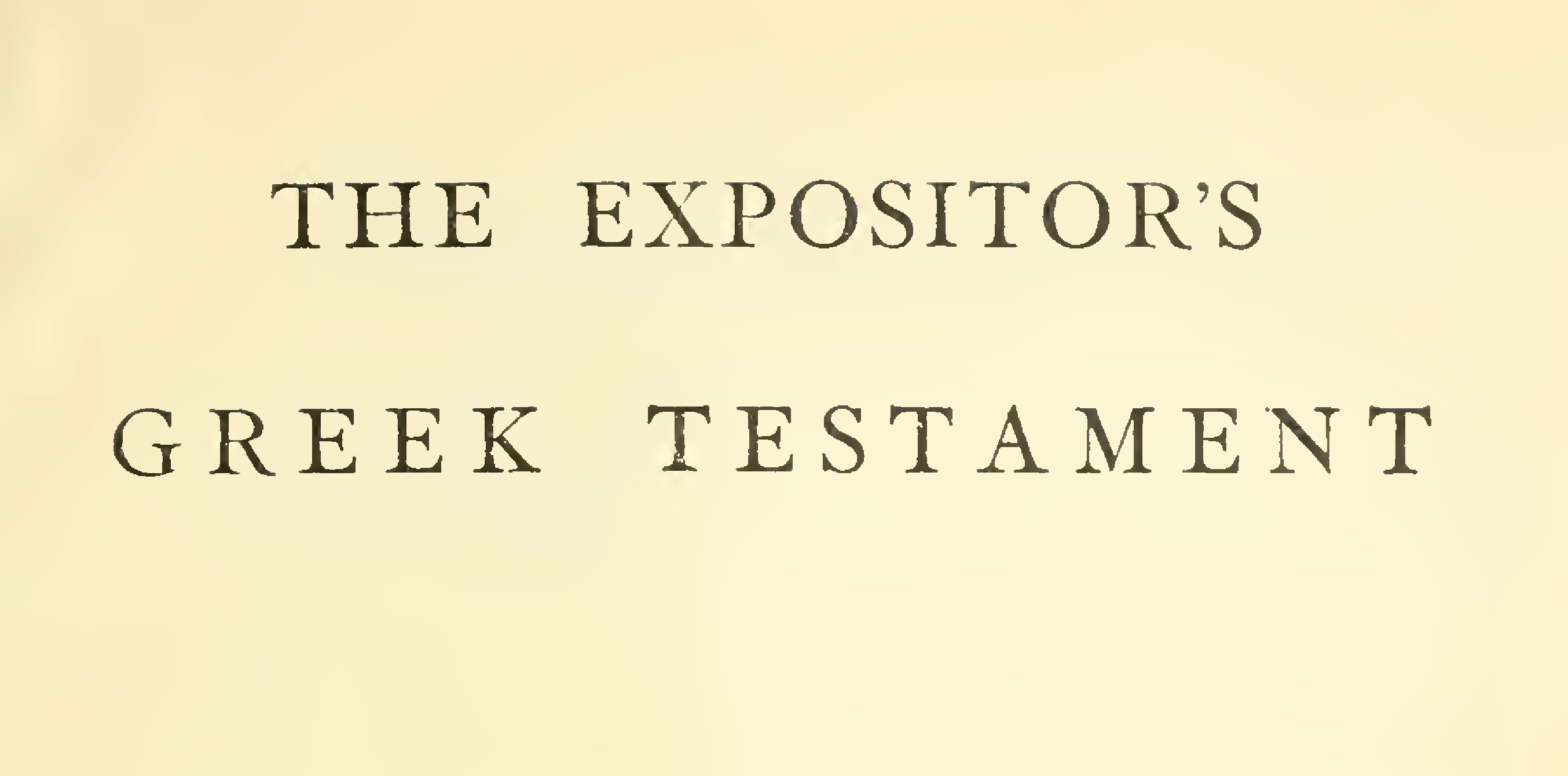The Expositor’s Greek Testament appeared in several editions after its initial release in 1897. Volumes from several printings released before 1923 are openly available online.1 While the Expositor’s Greek Testament is increasingly dated, it also preserves some keen exegetical insights that more recent commentators have continued to find helpful.
An Example: Baptism for the Dead
For example, G. G. Findlay wrote the section on 1 Corinthians (vol. 2, pp. 727–953), a letter where I’ve been spending a good deal of time lately. Findlay is often cited as one of the seminal proponents of the “dying mother” interpretation of “those who are being baptized in behalf of the dead” in 1 Cor 15:29. Findlay suggests,
P[aul] is referring … to a much commoner, indeed a normal experience, that the death of Christians leads to the conversion of survivors, who in the first instance “for the sake of the dead” (their beloved dead), and in the hope of reunion turn to Christ—e.g., when a dying mother wins her son by the appeal “Meet me in heaven!” … Paul designates such converts “baptised for the dead.” (931)
More recently, Maria Raedner, Anthony Thiselton, and others have continued to find this line of interpretation most persuasive.2
As all interpretations of 1 Cor 15:29 do, this reading has its virtues as well as its challenges. Pausing to point these out here would take me too far afield.
The important point here is rather the continued afterlife that Findlay’s comments from the Expositor’s Greek Testament have had in subsequent scholarship. Doubtless, there are other good similar examples that could be cited too.
So the Expositor’s Greek Testament certainly isn’t at the cutting edge of New Testament interpretation. But its contributors do make some helpful observations. And at the very least, the work remains important in the history of English-language New Testament scholarship.
Multiple Editions
With this in mind, it’s helpful to have a basic grasp of its publication history. As usual, you would typically want to refer to the most recent version of the Expositor’s Greek Testament.
This way, you get the version of the work that includes the most corrections, updates, and other improvements by comparison to previous versions.3 But this isn’t always easy given the publication information available for the Expositor’s Greek Testament—and often other older books too.
Doran
The first edition of the Expositor’s Greek Testament seems to have been released in 1897 by Doran. Courtesy of the University of Toronto, all five volumes of this edition are openly available online (vol. 1, vol. 2, vol. 3, vol. 4, vol. 5). It is this first edition that Logos reproduces in its release of the Expositor’s Greek Testament.
Hodder and Stoughton
A second edition then began appearing in 1901 under the auspices of Hodder and Stoughton. But it seems not all volumes in this edition note that they are from the “second edition.”
Published in 1901, at least some printings of vol. 2 explicitly identify themselves as a “second edition.” Other printings, however, do not, as is perhaps also the case for vol. 3, published in 1903.
Then, in 1910, Hodder and Stoughton released at least a partial 6th ed. Of this, vol. 1 and perhaps vol. 4 and vol. 5 are openly available online.
Dodd, Meade, & Co.
A further printing appeared by Dodd, Mead, & Co. in 1902–1910. Of this printing, at least three volumes are openly available online (vol. 1, vol. 4, vol. 5).
The front matter for vol. 1 of this printing also suggests that Dodd, Mead, & Co. held (or subsequently obtained?) the copyright to the Expositor’s Greek Testament dating back to the time of the first edition’s initial release by Doran in 1897.
Hendrickson and Eerdmans
In the early 2000s, Hendrickson reissued the Expositor’s Greek Testament. In these volumes, Hendrickson explicitly acknowledges that the pages of its edition are “reprinted from the edition originally published by Wm. B. Eerdmans Publishing Company.” The Hendrickson edition gives no further information about the provenance of its material, however.
Eerdmans published at least three (and perhaps more) runs of the Expositor’s Greek Testament respectively in 1967, 1974, and 1980. Presumably each of these runs traces its origins back to the same earlier edition(s) from 1897–1910. But in none of these three runs is there an explicit acknowledgement of which prior edition(s) provides the source for Eerdmans’s printing.
Conclusion
In the end, some of the publication history of the Expositor’s Greek Testament remains quite opaque. A fuller understanding of this history would likely yield clearer guidance about how best to consult this text.
For the moment, the most recent editions that are readily accessible online appear to be:
- The 1910 edition of vol. 1 by Hodder and Stoughton
- The 1901 edition of vol. 2 by Hodder and Stoughton
- The 1903 edition of vol. 3 by Hodder and Stoughton
- The 1910 edition of vol. 4 by either Hodder and Stoughton or Dodd, Meade, & Co.
- The 1910 edition of vol. 5 by either Hodder and Stoughton or Dodd, Meade, & Co.
Of course, the Hendrickson and Eerdmans copies are still more recent, but these are simply reproductions of one of the earlier editions. And it’s important to note too that if a possible difference between different editions is significant for a given research project, you may need to extend your search beyond what is already openly available online. But in the interim until the publication history of the Expositor’s Greek Testament becomes clearer, these online copies provide some excellent starting places for accessing this work.
Header image provided by Internet Archive. ↩
See Maria Raeder, “Vikariatstaufe in 1 Cor 15:29,” ZNW 46.3–4 (1955): 258–60; Anthony C. Thiselton, The First Epistle to the Corinthians: A Commentary on the Greek Text, NIGTC (Grand Rapids: Eerdmans, 2000), 1242–49. ↩
There are, however, exceptions to this rule. For an example, see “Migne’s ‘Patrologia Latina’: Mystery Solved” and “A Further Update on Migne’s ‘Patrologia Latina.’” ↩

Leave a Reply